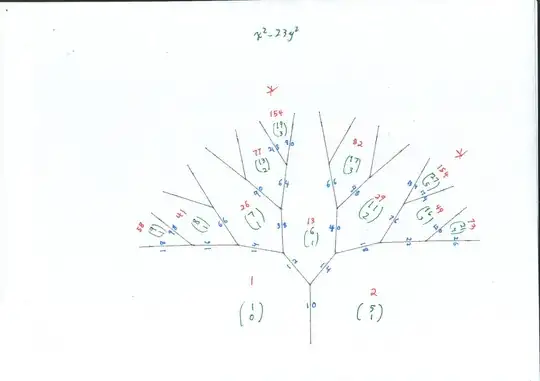EDIT, March 2016. Based on what people seemed to want in a recent question on Pell's equation, I wrote a program that solves $x^2 - d y^2 = k$ quite quickly, and identifies the "fundamental" solutions, from which all others can be found by applying the automorphism group.
jagy@phobeusjunior:~$ ./Pell_Target_Fundamental
24^2 - 23 5^2 = 1
x^2 - 23 y^2 = 154
Thu Mar 31 10:59:54 PDT 2016
x: 19 y: 3 ratio: 0.157895 fundamental
x: 27 y: 5 ratio: 0.185185 fundamental
x: 73 y: 15 ratio: 0.205479 fundamental
x: 111 y: 23 ratio: 0.207207 fundamental
x: 801 y: 167 ratio: 0.208489
x: 1223 y: 255 ratio: 0.208504
x: 3477 y: 725 ratio: 0.208513
x: 5309 y: 1107 ratio: 0.208514
x: 38429 y: 8013 ratio: 0.208514
x: 58677 y: 12235 ratio: 0.208514
x: 166823 y: 34785 ratio: 0.208514
x: 254721 y: 53113 ratio: 0.208514
x: 1843791 y: 384457 ratio: 0.208514
x: 2815273 y: 587025 ratio: 0.208514
x: 8004027 y: 1668955 ratio: 0.208514
x: 12221299 y: 2548317 ratio: 0.208514
Thu Mar 31 11:00:14 PDT 2016
x^2 - 23 y^2 = 154
jagy@phobeusjunior:~$
I decided to draw the complete diagram of the Conway topograph, first the river, then the two extensions (trees) away from the river that, together, give all orbits for representing $x^2 - 23 y^2 = 154,$ those four seed pairs being
$$ (19,3); \; (27,5); \; (73,15); \; (111,23). $$
As far as the original posted problem, the seeds for representing $x^2 - 23 y^2 = -11$ all occur along the river. Note that, as $x^2 - 23 y^2 \equiv x^2 + y^2 \pmod 4,$ whenever $x^2 - 23 y^2 \equiv 0 \pmod 4,$ it follows that both $x,y$ are even. That is, the seeds for $-11$ are $$ (9,2); \; (14,3), $$ therefore the only seeds for $-44$ are
$$ (18,4); \; (28,6). $$
You can see Ross's formula $(24x+115y, 5x+24y)$ at the far right of the river diagram, on graph paper. We see a representation of $1$ with column vector $(24,5)^T,$ below it and all the way to the edge of the paper, a representation of $-23$ with column vector $(115,24)^T.$ Put them side by side and we get the two by two matrix
$$
\left(
\begin{array}{cc}
24 & 115 \\
5 & 24
\end{array}
\right)
$$
of determinant $+1.$ That matrix, applied to a column vector $(x,y)^T,$ gives Ross's mapping.
I used a pink pen for the represented numbers in the two tree diagrams, it is a bit hard to read; next time, always red for the represented numbers.
I put four explanatory documents at OTHER with prefix indefinite_binary. For that matter, Conway's entire book is available at PDF





